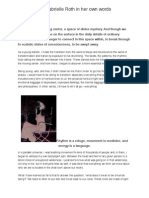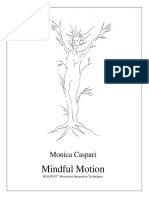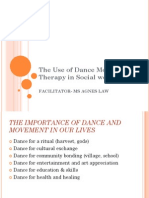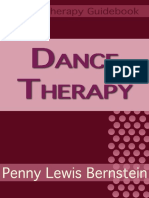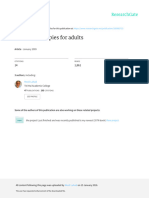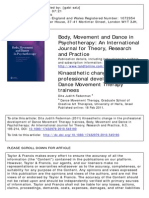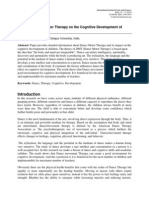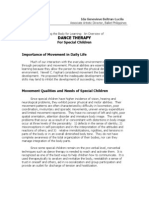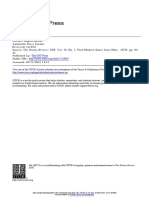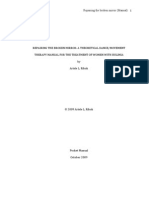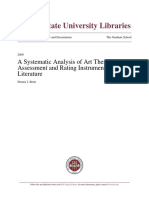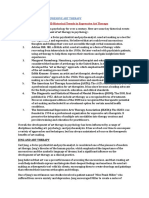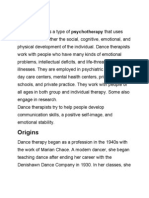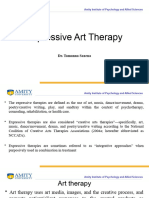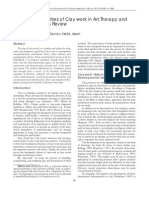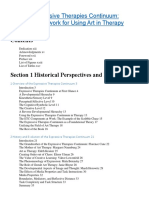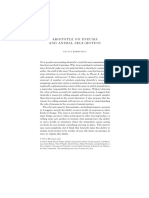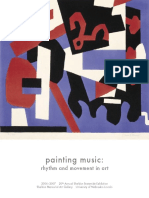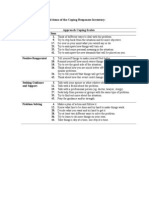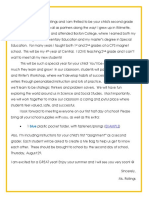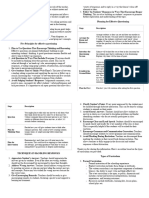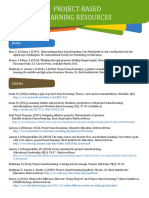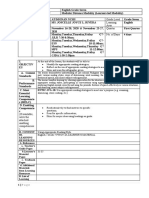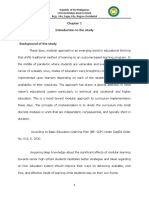Dance Movement Therapy
Dance Movement Therapy
Uploaded by
Humberto VirgüezCopyright:
Available Formats
Dance Movement Therapy
Dance Movement Therapy
Uploaded by
Humberto VirgüezOriginal Description:
Copyright
Available Formats
Share this document
Did you find this document useful?
Is this content inappropriate?
Copyright:
Available Formats
Dance Movement Therapy
Dance Movement Therapy
Uploaded by
Humberto VirgüezCopyright:
Available Formats
1
THE REGIONAL MAP:
AN OVERVIEW OF THIS
BOOK
T
his book introduces the reader to Dance Movement Therapy
(DMT) as a form of psychotherapy. I do this within the
metaphor of a journey. Before we embark on any journey we need
maps. The first part of the book therefore maps our territory. This
chapter maps the book as a whole, and sets the book in context by
giving an overview of DMT theory and practice. Chapter 2 offers a
more detailed map of DMT theory. Theory gives us a way of
understanding what DMT is and how it works. My dissatisfaction
with the pasting on of theories from other disciplines (usually
verbal psychotherapy) has led me to re-examine DMT. I propose a
unified theory of DMT, emphasising the creative process and in
particular the role of the movement metaphor.
In the second part of this book, I describe my particular
approach to DMT practice. I organise this part around the idea of
DMT as a creative process, with its four aspects of preparation,
incubation, illumination and evaluation. I make use of extensive
reference to case study material in order to illustrate each stage of
the process.
In Chapter 3 I propose a containment approach to DMT,
suitable for the early preparation or warm-up phase of each session
and of the therapy as a whole, and for clients struggling with overpowering experiences. I then examine in Chapter 4 the role of DMT
in allowing the process to deepen and in developing insight. This is
the stage of confrontation with dungeons and dragons, a letting-go
into the darkness (incubation) before seeing a crack of light (illumination). I end in Chapter 5 with a consideration of the role of DMT in
MAPPING
THE
TERRITORY
processing and evaluating transitions, as we settle around the final
campfire. At the end of the book are references and useful
addresses, should you wish to explore further the topics raised in
this book.
My case vignettes are all based on real experience, though some
are presented as composite pictures or with certain characteristics changed or disguised in order to protect confidentiality.
Changes are only made where this does not affect the validity of
the point being made. Pseudonyms are used throughout.
What is Dance Movement Therapy?
In Britain, DMT is defined as: the psychotherapeutic use of
movement and dance through which a person can engage creatively in a process to further their emotional, cognitive, physical
and social integration (ADMT UK, 1977).
What is interesting about this definition is that it places DMT
firmly within the realms of psychotherapy. For many years, mainstream psychotherapy in the UK was envisaged solely as a talking
therapy, and psychoanalytic or at least psychodynamic in its
orientation. With the advent of psychotherapy registration via the
United Kingdom Council for Psychotherapy (UKCP) it has been
possible to embrace all three of the major schools of psychotherapeutic thought (psychodynamic, behavioural and humanistic) and
more. Nevertheless, the arts therapies (dramatherapy, art therapy,
music therapy and DMT) are generally not represented within
UKCP and maintain their own systems of registration.
Dance Movement Therapy or Therapeutic Dance?
One of the confusions that abounds in many peoples minds
concerns the overlap between therapeutic dance and dance movement therapy. A lot of very valuable work goes on in the area of
therapeutic dance, and both professions are required in order to
meet the varied needs of our society. However, it is worth attempting to delineate the differences and similarities.
Therapeutic dance may be practised by talented and highly
skilled dance teachers who are not trained as therapists but work
within institutions such as schools, prisons and so on. There is
considerable overlap between DMT and therapeutic dance, giving
rise to some fruitful cross-fertilisation. One important figure in the
4
THE REGIONAL MAP: OVERVIEW
development of DMT in Britain has been the dance artist Wolfang
Stange, who works with mixed groups of dancers including those
with learning and physical disabilities. His goals are artistic; he
runs a performance group, yet his methods look very similar to
those used by dance movement therapists.
Both dance movement therapists and dancers working in therapeutic contexts are artists. Table 1.1 offers a comparison between
the two disciplines. This is based both on my own practical
experience and on the following sources: Boas (1943); Carnegie
UK Trust (1985); Chace (1975); Claid (1977); Davidson (1979); Gill
(1979); Hamilton (1989); Kestenberg and Sossin (1979); King
(1983); Laban (1971); Leventhal (1986); Levy (1992); Malecka
(1981); Meekums (1990); Meier (1997); Paludan (1977); Payne
(1992); Prestidge (1982); Sherborne (c.1984); Solway (1988); Standing Committee of Arts Therapies Professions (1989); Stanton-Jones
(1992); Steiner-Celebi (1996); Winnicott (1971). In reading my
comparison, it is important to remember that this is an evolving
field and that the parameters of each discipline are constantly
changing. Table 1.1 should therefore be viewed as a snapshot in
time.
Allied Approaches to DMT
Other approaches to movement and dance that may be seen as
allied to DMT include:
Body Mind CenteringTM (BMC) (Cohen 1980, 1984), a complex
training based on both developmental movement and anatomy.
BMC is used both to support performance and as a system of
therapy. Several British dance movement therapists have
trained in BMC, but by no means all BMC practitioners have
registration as dance movement therapists.
Gabrielle Roths five rhythms (flowing, staccato, chaos, lyrical,
stillness), which she views as a form of shamanism (1990). As
the name suggests, the work centres around five rhythmic
structures within which the dancer improvises.
Circle dance, based on folk dances from around the world and
often deemed to hold archetypal, healing significance. I discuss
their usefulness with survivors of child sexual abuse in my
book Creative Group Therapy for Women Survivors of Child
Sexual Abuse (2000). I have also encouraged some groups to
choreograph their own circle dance, based on a given theme
5
MAPPING
THE
Table 1.1
TERRITORY
Comparison of DMT and Therapeutic Dance
Field
DMT
Therapeutic Dance
Facilitator is an artist
Yes
Yes
Boundaries
Start and finish times, group
rules, private space,
confidentiality, limits to
relationship (no
socialisation).
Start and finish times and
privacy of space may be
more relaxed. Group rules
may be relaxed or strict.
Relationships may extend
beyond the group.
Use of structure offered
by leader
Probably, but in response to
therapeutic goals and
clients own contribution.
Likely to be flexible.
Probably. Not necessarily
responsive to the clients
contribution. May be rigidly
adhered to, or flexible.
Use of props
Probably. May be used as
transitional objects
(Winnicott, 1971).
Probably. Used to stimulate
creativity.
Performance to outside
audience
Unlikely
Possibly
Performance to other
members of group
Possibly
Probably
Use of choreographic
structures
Possibly
Possibly
Use of improvisational
structures
Definitely
Probably
Use of rhythm
Yes. To structure and
contain. Also to develop
certain psychological/
developmental states.
Yes. To structure and
contain, and to develop
skills.
Use of mirroring
(rhythm, quality and
shape of movement)
Yes. Conscious use to
develop therapeutic
relationship and group
interrelationships.
Yes. May be used as a
choreographic device or to
develop group
interrelationships.
Use of costume
Limited
Possibly
Use of theatre lighting
Unlikely
Possibly
Typical group size
1 to 8 or 10 individuals
4 to 30 or more individuals
Emphasis on aesthetic
components
No
Possibly
Aims
Targeted to the therapeutic
needs of the client group.
Broadly therapeutic and
sometimes educational/
artistic.
THE REGIONAL MAP: OVERVIEW
Table 1.1
continued
Field
DMT
Therapeutic Dance
Theoretical
underpinnings
Include psychological
theories.
May or may not include
psychological theories.
Client groups
Just about anybody, but may
be subject to assessment.
Just about anybody, but may
be targeted.
Competencies required
Experience in facilitation of
groups and range of
movement styles. Additional
competencies including
ability to work with distress.
Experience in facilitation of
groups and in the
movement form offered.
Own therapy required
Yes
No
Clinical supervision
required
Yes
No
Level of academic
training required
Post-graduate diploma
minimum
No formal qualifications
required
Work with group
dynamics and
interpersonal
relationships
Definitely
Probably
Work with the internal
imagery and symbolism
of clients
Definitely
Probably
Integration of spiritual
components
Possibly
Possibly
Distress versus fun
Actively work with distress,
but fun is allowed and used
to balance. Rescuing by
therapist avoided.
May avoid distress and
emphasise fun.
Alternatively, facilitator may
act as shaman, rescuing
through the use of self.
Verbal evaluation of
sessions
Usually
Not necessarily
Use of touch between
therapist and clients
Rare
Occurs as part of normal
interaction
Diagnostic or
psychological
formulation based on
movement observation
Yes
Not necessarily
MAPPING
THE
TERRITORY
like empowerment. These dances, performed at the end of
each session, become a container for the sessions material and
reaffirm a sense of connectedness before leaving the session.
Key Principles Underpinning DMT
Dance movement therapy rests on certain theoretical principles.
These are:
Body and mind interact, so that a change in movement will
affect total functioning (Berrol, 1992; Stanton-Jones, 1992)
Movement reflects personality (North, 1972; Stanton-Jones,
1992).
The therapeutic relationship is mediated at least to some extent
non-verbally, for example through the therapist mirroring the
clients movement (Chaiklin and Schmais, 1979; Stanton-Jones,
1992)
Movement contains a symbolic function and as such can be
evidence of unconscious processes (Schmais, 1985; StantonJones, 1992).
Movement improvisation allows the client to experiment with
new ways of being (Stanton-Jones, 1992).
DMT allows for the recapitulation of early object relationships
by virtue of the largely non-verbal mediation of the latter
(Meekums, 1990; Trevarthen, 2001).
The Evolution of Dance Movement Therapy
Dance Movement Therapy has had a separate development in the
UK from the American experience. Whilst there have been American influences, it is true to say that some of the seeds of British
DMT were being sewn before any significant input from American
dance movement therapists began in the late 1970s and 1980s.
There are records of dance being used for therapeutic purposes
in Britain during the nineteenth century (Browne, 1837). By the
1940s, a definite dance therapy movement had begun, paralleling
that in the US. However, dance therapy at that time was seen as
distinct from psychotherapy and it was not until the 1970s that a
second wave of DMT pioneers began to experiment with the
psychotherapeutic applications of dance and movement. This second wave eventually gave birth to DMT as we know it today in the
UK, and is more akin to American practice.
8
THE REGIONAL MAP: OVERVIEW
Dance movement therapy in the twenty-first century is practised
flexibly, either as a primary intervention and therefore as a form of
focal psychotherapy, or as a supportive, adjunctive therapy. The
more creative, supportive and adjunctive function of DMT overlaps
in form and function with therapeutic dance.
Training and Registration of Dance Movement Therapists
Training in the UK is at post-graduate level, for two or more years.
Some courses offer a post-graduate diploma and others offer
Masters level training. Courses are accredited via the professional
association, the Association for Dance Movement Therapy UK
(ADMT UK). During training, all DMT students must be in personal
therapy. Theoretical training spans several academic disciplines
including psychology, psychotherapy, anatomy and physiology, and
of course dance movement therapy. Practical training includes
weekly attendance at a DMT process group, 200 hours of client
contact and 200 hours of non-contact related work activity (notetaking, staff meetings and other related activity). Practice is supervised both in a group setting and individually.
In Britain, there are three tiers of registration for dance movement therapists. The first of these, Basic Registration (BRDMT) is
for those who have recently completed a post-graduate training in
DMT. BRDMT is essentially a probationary qualification. Within
two years, a BRDMT has to apply for Registered status (RDMT),
having completed extra hours of supervised practice.
Senior Registered Dance Movement Therapists (SRDMT) have
demonstrated extra supervised practice and personal therapy and
submitted a paper of publishable standard. They qualify for private
practice, teaching and supervision of others. SRDMTs have effectively been in training for approximately seven years (two years
post-graduate training, two years as a BRDMT and a further three
years as RDMT). RDMTs have been in training for up to four years.
All fully registered British Dance Movement Therapists have thus
had a similar length of training to that of any registered psychotherapist.
At present British dance movement therapists do not have
registration with one of the formal psychotherapy bodies (for
example, UKCP). It may be that the future of the profession lies in
acknowledging that there are two ways of practising DMT: the
more creative, supportive and adjunctive work on the one hand
9
MAPPING
THE
TERRITORY
(for BRDMTs) and the practice of DMT as a primary psychotherapeutic intervention on the other (for RDMTs and SRDMTs). The
latter could conceivably negotiate status as psychotherapists via
UKCP. The stumbling block to such registration has been to date
that many, but not all, dance movement therapists would wish to
be seen as psychodynamically orientated. However, they would be
unlikely to be afforded equal status with their counterparts in
verbal psychodynamic psychotherapy. The UKCP has no separate
category for arts therapists, although one member organisation
trains its students in an integrative arts therapies approach and
registers under the humanistic and integrative section.
Practice Contexts for DMT
Dance movement therapists in Britain work with a wide range of
client groups. Many work in the National Health Service (NHS),
usually in adult mental health. Others work in child and/or family
services, both statutory and voluntary agency based. Some dance
movement therapists work in social services, for example with
adults who have learning disabilities. Other locations and client
groups include prisons, education (with children who have emotional and behavioural disturbance) and private practice.
The Importance of Research
There is a strong and growing trend in Britain towards evidence
based practice (EBP) within the NHS. This has been driven by a
series of government initiatives and is broadly welcomed by the
profession. It is important that clients and referrers can make
informed choices wherever possible concerning treatment options.
Most importantly, clients should not be offered a form of treatment
that is unlikely to benefit or may even damage them.
The gold standard for research is taken as the Randomised
Controlled Trial (RCT). In this form of research, adapted from the
natural sciences (physics, chemistry and biology), DMT is offered
to one group of individuals (the experimental group), and the
same number of individuals is offered treatment as usual (the
control group). The allocation to each of these two groups is
random in an attempt to minimise researcher bias. A series of valid
and reliable measures relating to the research question is used with
both the experimental and control groups, at similar intervals,
10
THE REGIONAL MAP: OVERVIEW
usually equating to before and after therapy. For example, if the
research question is Does DMT reduce depression? the measure
will be a depression scale such as the Beck Depression Inventory
(Beck, 1978). Statistical tests are then applied to the data to
ascertain whether any difference in outcome between the two
groups is deemed to be significant. A significant difference implies
a causal relationship. For example, if the experimental group
(those receiving DMT) show a statistically significant decrease in
scores on the Beck Depression Inventory as compared to the
control group (treatment as usual), it is considered likely that DMT
has caused a reduction in depression in the experimental group.
Experimental research has demonstrated a role for DMT in
reducing anxiety (Cruz and Sabers, 1998; Erwin-Grabner et al.,
1999; Low and Ritter, 1998; Ritter and Low, 1996). As a form of
gentle exercise, it is likely also that DMT has all of the positive
health effects generally associated with this, including potentially
the alleviation of depression (Ernst et al., 1998). However, there
are fundamental problems with experimental methodology when
applied to DMT research. It is often difficult to gather sufficient
numbers to obtain a reliable result. The research is also limited by
the measures available, so that it is difficult to investigate phenomena associated with complex symptom pictures or changes in
beliefs, attitudes, feelings and relationships. Some research has
focussed on the practice of developing DMT by participating with
service users. This kind of research typically makes use of focus
groups or conversational interviews and generates complex
descriptive data rather than numerical data. Conclusions are likely
to be similarly complex. For example, my own research (Meekums,
1998) showed that some women who had been sexually abused as
children needed to use DMT in a very structured way in order to
feel safe, while others benefited from the freedom of expression
afforded through less structured, improvisatory forms. This difference seemed to be determined by the womans degree of emotional
and cognitive distance from the abuse. Distance is a complex
phenomenon that cannot be reduced to one single factor, for
example length of time spent in treatment.
Navigating this Book
It is important not to skip the theory chapter of this book (Chapter
2), as this will help the reader to make sense of the practice of
11
MAPPING
THE
TERRITORY
DMT. My central thesis in this book is that DMT is a form of
psychotherapy in its own right, mediated via the creative process
and making unique use of the movement metaphor in order to
facilitate this process.
I hope that the reader will take from this book whatever is of use
to them. However, I must emphasise that it is not advisable or ethical
(and may soon be illegal in the UK) to practice dance movement therapy without full training. An experienced practitioner from
an allied discipline (for example dramatherapy, psychodrama, therapeutic dance or perhaps occupational therapy) will know their
own competencies and be able to select from the ideas I present
here to inform their own practice. Expert clinical supervision is
essential in order to examine the boundaries of ones own competence and comfort with the material. The student or qualified
practitioner in dance movement therapy will be able to use this
book to confirm or develop their own thinking and practice.
12
You might also like
- Neurocognitive DanceDocument12 pagesNeurocognitive DanceKristina Kljucaric100% (1)
- 5 Rhythms Dance by Gabrielle RothDocument4 pages5 Rhythms Dance by Gabrielle RothpsiqueblogNo ratings yet
- Helen Payne-Dance Movement Therapy Theory and Practice 1992Document292 pagesHelen Payne-Dance Movement Therapy Theory and Practice 1992Mary Anne Minas100% (12)
- Every Little Movement: A Book About DelsarteFrom EverandEvery Little Movement: A Book About DelsarteRating: 4.5 out of 5 stars4.5/5 (2)
- Paul Newham - Using Voice and Song in TherapyDocument152 pagesPaul Newham - Using Voice and Song in TherapyLaimis Motuza75% (4)
- Dance and Other Expressive Art Therapies When Words Are Not EnoughDocument8 pagesDance and Other Expressive Art Therapies When Words Are Not EnoughPaola Rico100% (1)
- (Sue Jennings) The Handbook of DramatherapyDocument240 pages(Sue Jennings) The Handbook of DramatherapyAlice Dinu - Terpez100% (4)
- The PseudonomiconDocument35 pagesThe PseudonomiconByblos Caotica89% (9)
- Magic From MexicoDocument141 pagesMagic From Mexicoraul49No ratings yet
- Dance/movement Therapy and Bulimia NervosaDocument89 pagesDance/movement Therapy and Bulimia Nervosaalriboh100% (1)
- Mindful Motion CaspariDocument103 pagesMindful Motion CaspariKian Fallahi100% (1)
- Creative Facilitation ManualDocument55 pagesCreative Facilitation ManualHumberto VirgüezNo ratings yet
- The Use of Dance Movement Therapy in Social WorkDocument16 pagesThe Use of Dance Movement Therapy in Social Workdrovoca100% (3)
- Dance TherapyDocument10 pagesDance Therapyzarrar100% (1)
- Dance Movement TherapyDocument10 pagesDance Movement TherapyAdrian Alovera100% (1)
- Creative Movement TherapyDocument4 pagesCreative Movement TherapyNupur NatarajaNo ratings yet
- Body Psychotherapy and Dance Movement PsychotherapyDocument24 pagesBody Psychotherapy and Dance Movement Psychotherapytaspre100% (1)
- Creative Therapies For AdultsDocument35 pagesCreative Therapies For AdultsHector OrgenaneroNo ratings yet
- Kinaesthetic Change PDFDocument22 pagesKinaesthetic Change PDFGabriella SalzNo ratings yet
- Effect of Dance Motor Therapy On The Cognitive Development of Children PDFDocument19 pagesEffect of Dance Motor Therapy On The Cognitive Development of Children PDFLissette Tapia Zenteno100% (1)
- Dance TherapyDocument17 pagesDance TherapySaheli Mukherjee100% (3)
- Dance Movement TherapyDocument7 pagesDance Movement TherapyEdward RubioNo ratings yet
- Dance Therapy 4 Best Techniques For Healing With RhythmDocument14 pagesDance Therapy 4 Best Techniques For Healing With RhythmRitaNo ratings yet
- Dance Therapy Data CollectDocument11 pagesDance Therapy Data CollectLeong Yong SiNo ratings yet
- A10. Dance TherapyDocument7 pagesA10. Dance TherapyFrancis A. BuenaventuraNo ratings yet
- Dance TherapyDocument167 pagesDance TherapyCissiVR100% (2)
- Exercise and Dance Therapies For PsychiaDocument4 pagesExercise and Dance Therapies For PsychiaArabelle GO100% (1)
- Paxton Contact ImprovisationDocument4 pagesPaxton Contact ImprovisationRAFAEL VICENT ARNAL RODRIGONo ratings yet
- Body, Movement and Dance in PsychotherapyDocument18 pagesBody, Movement and Dance in PsychotherapytaspreNo ratings yet
- Dance Therapy As Treatment of Choice For The Emotionally Disturbed Learning Disabled ChildDocument4 pagesDance Therapy As Treatment of Choice For The Emotionally Disturbed Learning Disabled ChildCarl CannonNo ratings yet
- The Parts Do Make The WholeDocument42 pagesThe Parts Do Make The WholeNathan Andary100% (1)
- Dance/movement Therapy and Bulimia Nervosa (Manual)Document35 pagesDance/movement Therapy and Bulimia Nervosa (Manual)alriboh100% (1)
- Drama and Movement TherapyDocument10 pagesDrama and Movement TherapyduramemoriaNo ratings yet
- Body Art Therapy New PaperDocument24 pagesBody Art Therapy New Paperapi-310061898No ratings yet
- Dance Therapy With Emil, A Child With AutismDocument3 pagesDance Therapy With Emil, A Child With AutismRachelle Smith-StallmanNo ratings yet
- Journal of Dance & Somatic Practices 1.1Document138 pagesJournal of Dance & Somatic Practices 1.1Intellect Books100% (5)
- Dancing Mindfulness and Our Emotions - Embracing The Mind BodyDocument39 pagesDancing Mindfulness and Our Emotions - Embracing The Mind BodyElisabeth JatuNo ratings yet
- How The Expressive Therapies Continuum Informs Intermodal TransfeDocument37 pagesHow The Expressive Therapies Continuum Informs Intermodal TransfePamela Cantillana100% (1)
- 2012 Dance Movement Therapy Social Work HandoutsDocument12 pages2012 Dance Movement Therapy Social Work Handoutsgeo_gabe_galan5473100% (1)
- Mindful Multicultural Dance Therapy: Integrating Mind-Body-Spiritual Worlds For Compassionate Healing of Us and Our CommunityDocument6 pagesMindful Multicultural Dance Therapy: Integrating Mind-Body-Spiritual Worlds For Compassionate Healing of Us and Our CommunitygranadilloNo ratings yet
- Autentic MovementDocument13 pagesAutentic MovementVeron Pabon100% (1)
- A Systematic Analysis of Art Therapy AssessmentDocument155 pagesA Systematic Analysis of Art Therapy AssessmentBolya Tania RoxanaNo ratings yet
- Art and HealingDocument3 pagesArt and HealingAna Maria De OsmaNo ratings yet
- Dunphy K. Mullane S. and Jacobsson M. 20 PDFDocument32 pagesDunphy K. Mullane S. and Jacobsson M. 20 PDFТатьяна ПотоцкаяNo ratings yet
- Art TerapyDocument9 pagesArt TerapyDyana DeasyNo ratings yet
- Music and Dance Therapy BasicsDocument6 pagesMusic and Dance Therapy BasicsljparsonsNo ratings yet
- Breathing Sensing and Expressing Emotions The Influence of Elsa Gindler and Mary Wigman On Body Psychotherapy and Dance Movement TherapyDocument16 pagesBreathing Sensing and Expressing Emotions The Influence of Elsa Gindler and Mary Wigman On Body Psychotherapy and Dance Movement Therapyhelena100% (1)
- Expressive Art NotesDocument54 pagesExpressive Art NotesRiya VasisthNo ratings yet
- A Conversational Model of Art TherapyDocument20 pagesA Conversational Model of Art TherapyDiana99No ratings yet
- Body and Voice SomaticDocument13 pagesBody and Voice SomaticFao MirandaNo ratings yet
- BARTENIEFF FUNDAMENTALS AND SOCIAL TRANSFORMATION - Noc.2018Document11 pagesBARTENIEFF FUNDAMENTALS AND SOCIAL TRANSFORMATION - Noc.2018Regina MirandaNo ratings yet
- Body Oriented Therapies and PsychotherapiesDocument24 pagesBody Oriented Therapies and Psychotherapiesroselita321No ratings yet
- Dance TherapyDocument13 pagesDance TherapyCaress Mae Gubaton Cabudoy100% (2)
- Principles of ChoreographyDocument1 pagePrinciples of ChoreographyOhiwei OsawemenNo ratings yet
- Expressive Art TherapyDocument19 pagesExpressive Art Therapynalwavedangi.031No ratings yet
- Therapeutic Qualities of CLAY Work in Art TherapyDocument7 pagesTherapeutic Qualities of CLAY Work in Art TherapyHehe ArtNo ratings yet
- Somatic Therapy: Reporter: Daryl S. AbrahamDocument10 pagesSomatic Therapy: Reporter: Daryl S. AbrahamBiway RegalaNo ratings yet
- Evaluation of A Social Skills Program Using Art Therapy PDFDocument10 pagesEvaluation of A Social Skills Program Using Art Therapy PDFLNo ratings yet
- Drama TherapyDocument12 pagesDrama TherapyShera Bahadur100% (3)
- TOC Expressive Therapies Continuum PDFDocument6 pagesTOC Expressive Therapies Continuum PDFManu Sato0% (1)
- Somatic Psychology Linda Hartley Review PDFDocument8 pagesSomatic Psychology Linda Hartley Review PDFAndres SanabriaNo ratings yet
- Art TherapyDocument13 pagesArt Therapyapi-2776195270% (1)
- The Art of Loving as Tree. Me, You and Us: Theory and practice for couple relationshipsFrom EverandThe Art of Loving as Tree. Me, You and Us: Theory and practice for couple relationshipsNo ratings yet
- Aristotleonpneuma Andanimalself-Motion: Aith Er, The Stu of The Stars? A Second Puzzle-One That Has ReceivedDocument14 pagesAristotleonpneuma Andanimalself-Motion: Aith Er, The Stu of The Stars? A Second Puzzle-One That Has ReceivedHumberto VirgüezNo ratings yet
- Striim White Paper v1 0Document34 pagesStriim White Paper v1 0Humberto Virgüez0% (1)
- Migene González-Wippler - Santeria - The Religion Faith, Rites, MagicDocument384 pagesMigene González-Wippler - Santeria - The Religion Faith, Rites, MagicMs Daisy80% (15)
- Painting MusicDocument12 pagesPainting MusicHumberto Virgüez100% (1)
- Invocation To Our Lady of Midnight Liliya-Devala PDFDocument3 pagesInvocation To Our Lady of Midnight Liliya-Devala PDFHumberto Virgüez50% (2)
- Thesis Cousins R ScalesDocument2 pagesThesis Cousins R ScalesHumberto VirgüezNo ratings yet
- A Survey of Treatment Procedures in Improvisational Music TherapyDocument23 pagesA Survey of Treatment Procedures in Improvisational Music Therapyywwonglp100% (1)
- The Secret of Joy in Work Is Contained in One Word - : FiitjeeDocument1 pageThe Secret of Joy in Work Is Contained in One Word - : Fiitjeebhooshan japeNo ratings yet
- Roles of TeachersDocument19 pagesRoles of TeachersjoyceNo ratings yet
- Part 3 2 Reflection On Another Research Paper Phonology FinalDocument2 pagesPart 3 2 Reflection On Another Research Paper Phonology Finalapi-293772978No ratings yet
- MBBS 1st Theory NotificationDocument2 pagesMBBS 1st Theory NotificationkrishnaNo ratings yet
- (Bonnie S. McDougall) Love-Letters and Privacy inDocument320 pages(Bonnie S. McDougall) Love-Letters and Privacy inBeatriz Hernández100% (1)
- Teacher Resume Example TemplateDocument2 pagesTeacher Resume Example TemplateZhelParedesNo ratings yet
- Central Welcome Letter 2019Document2 pagesCentral Welcome Letter 2019api-345004824No ratings yet
- SAP Bootcamp RecruitmentDocument2 pagesSAP Bootcamp RecruitmentWong Tze BoonNo ratings yet
- Education JapanDocument15 pagesEducation JapanDylanEga CandradipuraNo ratings yet
- Reviewer Ma'Am EyoDocument7 pagesReviewer Ma'Am EyoAliya JimenezNo ratings yet
- Sara Kash-Brown ResumeDocument2 pagesSara Kash-Brown Resumeapi-251830692No ratings yet
- Principles in Teaching Multigrade ClassesDocument19 pagesPrinciples in Teaching Multigrade ClassesKent GarciaNo ratings yet
- PKBLDocument2 pagesPKBLRama MaulidinNo ratings yet
- Lesson Plan FunctionsDocument5 pagesLesson Plan FunctionsUmdatun Nafiah0% (1)
- NELTAL ProceedingsDocument290 pagesNELTAL Proceedingsainkqe0% (1)
- ED123 - Unit 3 - Lesson 2 2Document16 pagesED123 - Unit 3 - Lesson 2 2Hezel Cabunilas100% (1)
- ZerotoThree Guidelines PDFDocument34 pagesZerotoThree Guidelines PDFwolfdare11No ratings yet
- CV of Kaniz Fatema MouDocument2 pagesCV of Kaniz Fatema MouOnik Sunjy Dul IslamNo ratings yet
- Notification PGIMER Chandigarh Principal Public Relation Officer JR Technician LDC Othe Posts PDFDocument18 pagesNotification PGIMER Chandigarh Principal Public Relation Officer JR Technician LDC Othe Posts PDFSatywan SainiNo ratings yet
- Hala Template CVDocument2 pagesHala Template CVhalabaroud88No ratings yet
- Politics and Governance in Spanish Colonial PhilippinesDocument15 pagesPolitics and Governance in Spanish Colonial PhilippinesVon VelascoNo ratings yet
- Lesson Exemplar Nov. 16-27-G7 - JJLRDocument4 pagesLesson Exemplar Nov. 16-27-G7 - JJLRJoscelle Joyce RiveraNo ratings yet
- 2016star Rittle-Johnson Math ChapterDocument47 pages2016star Rittle-Johnson Math ChapterAndiNath2No ratings yet
- Criteria of An Ideal Teacher ScriptDocument5 pagesCriteria of An Ideal Teacher ScriptMashudi MisbanNo ratings yet
- Boys Underachievement Causes and StrategiesDocument6 pagesBoys Underachievement Causes and StrategiesMonique MosesNo ratings yet
- Research 12Document40 pagesResearch 12Boliboli Mary, Pauline P.No ratings yet
- Statement of Purpose: and Miles To Go Before I Sleep. and Miles To Go Before I Sleep."Document6 pagesStatement of Purpose: and Miles To Go Before I Sleep. and Miles To Go Before I Sleep."JatinKumarNo ratings yet
- Contoh Lesson Plan Total Physical ResponseDocument12 pagesContoh Lesson Plan Total Physical ResponseUlfie Ghieza100% (1)
- Accomplishment Report As Youth VolunteerDocument1 pageAccomplishment Report As Youth VolunteerPaul Bryan Bron50% (2)
- Lesson Plan - The Role of WomenDocument3 pagesLesson Plan - The Role of Womenjkjahkjahd987981723No ratings yet

